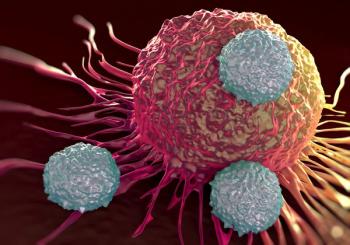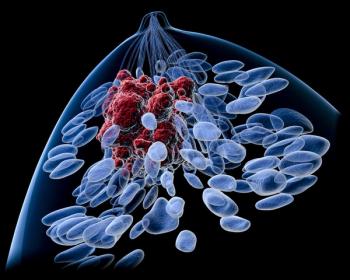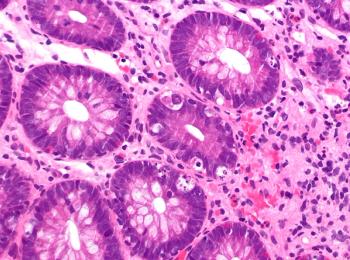
PD-1 and PD-L1 Inhibitor Combos Show Similar Real-World Efficacy in ES-SCLC
Data from a real-world study may help clinicians in treatment decision-making for those with extensive-stage small cell lung cancer who are unable to afford PD-L1 inhibitors.
Treatment with PD-1 inhibitors in combination with platinum-etoposide chemotherapy produced no significant differences in prognosis or efficacy compared with PD-L1 inhibitors plus chemotherapy in patients with extensive-stage small cell lung cancer (ES-SCLC), according to findings from a real-world study published in BMC Cancer.
With a median follow-up of 18.6 months for all patients, investigators reported a median progression-free survival (PFS) of 6.8 months (95% CI, 5.3-8.1) among patients who received PD-1 inhibitors compared with 6.4 months (95% CI, 5.5-7.5) in the PD-L1 inhibitor group (HR, 1.12; 95% CI, 0.83-1.53; P = .0452). Additionally, the PFS rate in each respective group was 49% vs 45% at 6 months and 12% vs 18% at 12 months.
The median overall survival (OS) was 15.8 months with PD-1 inhibitors and 17.7 months with PD-L1 inhibitors (HR, 0.90; 95% CI, 0.62-1.30; P = .566). Investigators also highlighted 12-month OS rates of 57% vs 60% and 18-month rates of 43% vs 49% in each respective group.
Findings from a subgroup analysis highlighted no significant differences in PFS and OS outcomes across the PD-1 and PD-L1 groups based on factors including age, sex, ECOG performance status, number of metastases, and radiotherapy administered to the brain.
“The two groups seemed to have comparable safety profiles, but the event numbers of discontinuation or death were too small to draw a firm conclusion,” the study authors wrote. “Clinically, our study may aid clinicians in decision-making and provide other options for patients with ES-SCLC who cannot afford PD-L1 inhibitors.”
In this real-world, multi-center, retrospective study, investigators assessed outcomes in patients with ES-SCLC who were treated at the PLA General Hospital from January 2017 to December 2021. All patients received a maximum of 6 cycles of etoposide at 80 to 100 mg/m2 body surface area on days 1 to 3 of each cycle, carboplatin area under the curve 5 to 6 mg/mL per minute on day 1, or cisplatin at 75 to 80 mg/m2 on day 1. Additionally, patients received treatment with PD-1 inhibitors including pembrolizumab (Keytruda) at 200 mg, nivolumab (Opdivo) at 360 mg, or sintilimab (Tyvyt) at 200 mg; or therapy with PD-L1 inhibitors such as atezolizumab (Tecentriq) at 1200 mg or 1500 mg of durvalumab (Imfinzi) intravenously every 3 weeks following etoposide-based chemotherapy.
The study’s primary end points were PFS and OS based on investigator assessment. Secondary end points included objective response rate (ORR), disease control rate, and duration of response (DOR) according to RECIST v1.1 guidelines.
Patients 18 years and older with histologically or cytologically confirmed ES-SCLC who received a PD-1 or PD-L1 inhibitor in combination with etoposide-containing chemotherapy as frontline treatment were included in the study. Having measurable disease per RECIST v1.1 criteria was another inclusion criterion.
The median age was 58 years (range, 32-80) in the PD-1 group (n = 93) and 61 years (range, 36-89) in the PD-L1 group (n = 101). In each respective group, most patients were male (86.0% vs 85.1%), had an ECOG performance status of 0 or 1 (77.4% vs 81.2%), no liver metastases (73.1% vs 77.2%), no brain metastases (78.5% vs 79.2%), and no bone metastases (65.6% vs 62.4%). Additionally, a minority of patients in each group received chest radiotherapy (38.7% vs 45.5%) and brain radiotherapy (18.3% vs 26.7%).
Investigators reported an ORR of 76.3% in the PD-1 group and 76.2% in the PD-L1 group; no patients achieved a complete response. The median DOR among responders in each respective group was 6.2 months (95% CI, 1.4-38.6) and 6.1 months (95% CI, 1.4-28.3), and ongoing responses were observed among 16.9% of patients in both groups.
Any-grade adverse effects (AEs) affected 82.7% of patients in the PD-1 group compared with 85.1% of those who received a PD-L1 inhibitor. Additionally, 33.3% and 33.7% of patients in each respective group experienced grade 3/4 AEs. Investigators highlighted any-grade immunotherapy-related AEs (IRAEs) in 24.7% and 32.7% of patients in each group; the respective rates of grade 3/4 IRAEs were 5.4% and 5.0%.
The most common any-grade treatment-related AEs in the PD-1 and PD-L1 groups, respectively, included neutropenia (60.2% vs 61.3%), anemia (52.6% vs 44.6%), and fatigue (32.3% vs 31.6%). Moreover, the most frequent IRAEs of any grade included lung toxicity (12.0% vs 14.0%), skin toxicity (10.0% vs 10.0%), and liver/pancreas toxicity (4.3% vs 4.0%).
Reference
Wang Y, Li L, Hu J, et al. Comparison of efficacy and safety between PD-1 inhibitors and PD-L1 inhibitors plus platinum-etoposide as first-line treatment for extensive-stage small-cell lung cancer: a multicenter, real-world analysis. BMC Cancer. 2023;23:1196. doi:10.1186/s12885-023-11709-1
Newsletter
Stay up to date on recent advances in the multidisciplinary approach to cancer.

















































































